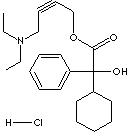| OXYBUTYNIN HYDROCHLORIDE | ||
|
PRODUCT IDENTIFICATION |
||
| CAS NO. |
5633-20-5
(Baes) |
|
| EINECS NO. | 216-139-7 | |
| FORMULA | C22H31NO3·HCl | |
| MOL WT. | 393.95 | |
|
H.S. CODE |
||
|
TOXICITY |
||
| SYNONYMS | Ditropan; | |
| alpha-Cyclohexyl-alpha-hydroxy Benzeneacetic acid, 4-(Diethylamino)-2-butynyl ester Hydrochloride; alpha-Phenylcyclohexaneglycolic acid 4-(Diethylamino)-2- Butynyl ester Hydrochloride; D,L-4-Diethylamino-2-butynyl phenylcyclohexylglycolate HCl; Ciclohexilfenilglicolato de 4-(dietilamino)but-2-inilo, clorhidrato; Cyclohexylphénylglycolate de 4-(diéthylamino)but-2-ynyle, chlorhydrate; | ||
| SMILES |
|
|
|
CLASSIFICATION |
||
|
PHYSICAL AND CHEMICAL PROPERTIES |
||
| PHYSICAL STATE | White to off-white crystalline powder | |
| MELTING POINT | 125 - 130 C | |
| BOILING POINT | ||
| SPECIFIC GRAVITY | ||
| SOLUBILITY IN WATER | Soluble (soluble in acids but insoluble in alkalis) | |
| pH | ||
| VAPOR DENSITY |
|
|
| AUTOIGNITION |
|
|
| NFPA RATINGS | ||
|
REFRACTIVE INDEX |
||
| FLASH POINT |
|
|
| STABILITY |
Stable under ordinary conditions. Moisture sensitive |
|
|
APPLICATIONS |
||
Oxybutynin in the form of a hydrochloride is used to relieve frequent urination and inability to control urination. It can be used as an anti-spasmodic or anticholinergic agent to decrease muscle spasms of the bladder by down regulation of growth promoting genes. |
||
| SALES SPECIFICATION | ||
| Oxybutynin Base | ||
|
APPEARANCE |
White to off-white crystalline powder | |
|
ASSAY |
99.0% min |
|
|
MELTING POINT |
56 - 58 C |
|
|
INDIVIDUAL IMPURITY |
0.1% max |
|
|
IMPURITY |
0.5% max |
|
| Oxybutynin Hydrochloride | ||
|
APPEARANCE |
White to off-white crystalline powder | |
|
ASSAY |
99.0% - 102.0% |
|
|
MELTING POINT |
125 - 130 C | |
|
SULFATE |
0.1% max |
|
| TRANSPORTATION | ||
| PACKING |
|
|
| HAZARD CLASS | ||
| UN NO. | ||
| OTHER INFORMATION | ||
| Hazard Symbols: , Risk Phrases: 22, Safety Phrases: 36 | ||
